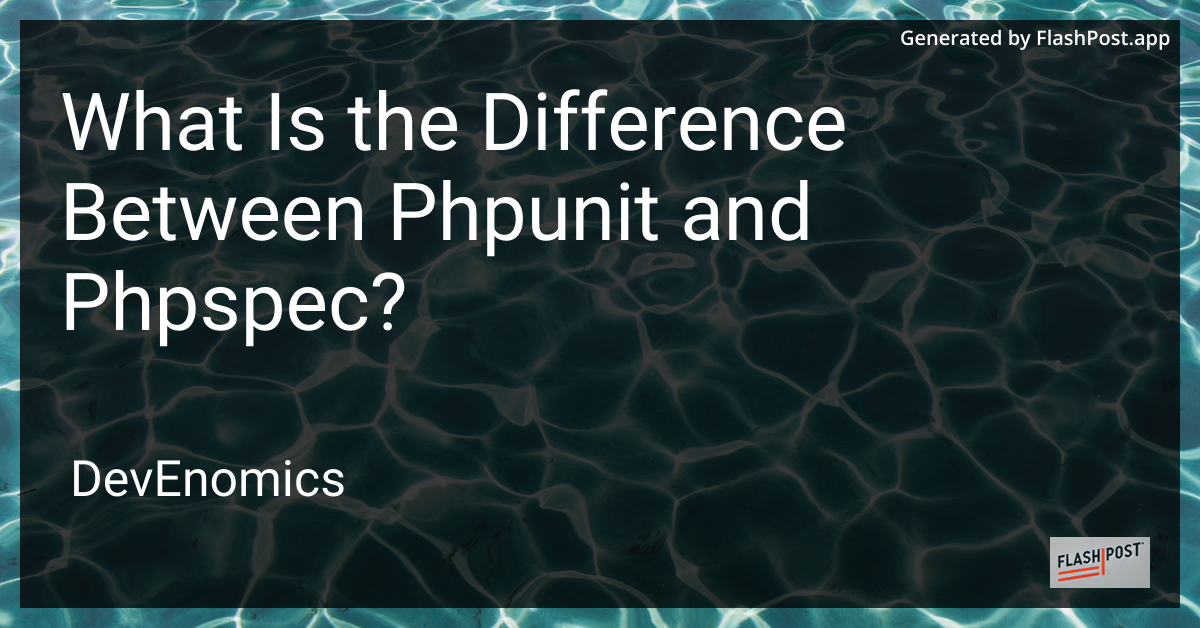

What Is the Difference Between Phpunit and Phpspec?
In the world of software development, testing is a pivotal aspect that ensures code reliability and integrity. Among the plethora of testing frameworks available for PHP, PHPUnit and PHPSpec stand out as prominent tools. Both frameworks cater to PHP developers, yet they serve distinct purposes and suit different testing philosophies. This article delves into the differences between PHPUnit and PHPSpec, helping you choose the right tool for your project’s testing needs.
Understanding PHPUnit
PHPUnit is a unit testing framework tailored to PHP. It’s designed to help developers test individual units of code, usually functions or classes, in isolation from other parts of the application. PHPUnit’s primary focus is on ensuring that each unit of code performs as expected under specific conditions.
Key Features of PHPUnit:
-
Test Driven Development (TDD): PHPUnit supports TDD, where developers write unit tests for their code first and refine the code until it passes the tests.
-
Mock Objects: With PHPUnit, you can create mock objects to test code in isolation without dependencies.
-
Code Coverage Analysis: It helps developers identify untested sections of code, ensuring comprehensive test coverage.
-
Integration with CI/CD: Easily integrates with continuous integration and delivery tools to automate testing processes.
Useful Links for PHPUnit:
- PHPUnit Configuration Guide
- Middleware Testing with PHPUnit in Laravel
- Another PHPUnit Configuration Resource
Understanding PHPSpec
PHPSpec is a tool designed for Behavioral Driven Development (BDD) in PHP. It emphasizes behavior specification rather than testing. With PHPSpec, you specify how the code should behave under different circumstances, which naturally encourages writing more maintainable and understandable code.
Key Features of PHPSpec:
-
Behavior Driven Development (BDD): PHPSpec adopts BDD principles, focusing on how the application behaves, rather than merely checking if specific pieces of code work.
-
Specification by Example: Instead of writing tests, PHPSpec encourages writing specifications by examples, closely aligning with user stories or requirements.
-
Encourages Clean Code: By focusing on behavior, PHPSpec encourages developers to write clean, readable, and simple code.
-
Mocks and Doubles: Supports creating doubles for classes and interfaces to isolate the code being specified.
Comparing PHPUnit and PHPSpec
Purpose and Philosophy
-
PHPUnit is primarily for unit testing. It verifies if individual pieces of your application work as expected by running tests on isolated units of code.
-
PHPSpec is centered around specifying and verifying the behavior of the application. It is used more for designing the behavior of functionalities through examples, adhering to a BDD approach.
API and Syntax
-
PHPUnit uses assertions to validate the outcomes of the tests against expected results, which involves writing actual test cases.
-
PHPSpec relies on specifications that describe the expected behavior, promoting readable and expressive code through a fluent interface.
Development Approach
-
With PHPUnit, you generally write tests against existing code, making sure that changes don’t break the current functionality.
-
With PHPSpec, you often write the behavioral specifications first, leading the development process by design.
Conclusion
Both PHPUnit and PHPSpec offer unique advantages and cater to different testing needs. If you are focused on ensuring code correctness through unit testing, PHPUnit is the appropriate choice. On the other hand, if you prefer to start with expected behaviors and design your application by example, PHPSpec would better suit your needs. Ultimately, the choice between these two tools should reflect your development and testing strategy, as well as the needs of your project. By understanding their strengths, you can leverage either or a combination of both to enhance the quality and reliability of your PHP applications.
